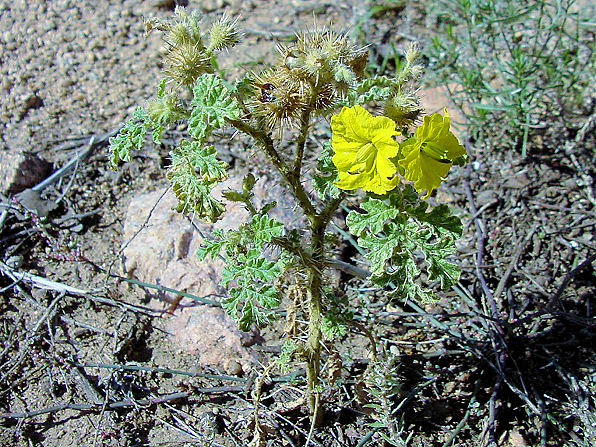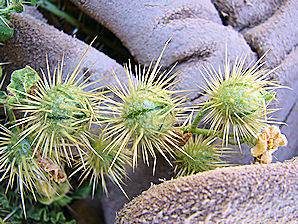Arizona Wild Flowers
Pictures, Photos, Images
Descriptions, Information, Reviews.
Buffalo Bur, Solanum rostratum.
We Are Proud Of Our SafeSurf Rating!
Click On Any Of The Following Links By Amazon.Com
For Books, & Videos About Wildflowers Of Arizona & The Southwest USA. No Obligation!
 |
| Buffalo Bur, Solanum rostratum. Photo Taken August 10, 2012. Yarnell, Arizona. |
|---|
 |
| Buffalo Bur, Solanum rostratum. Photo Taken October 27, 2005. Bloody Basin, Arizona. |
 | |
| Buffalo Bur, Solanum rostratum. | Buffalo Bur, Solanum rostratum. |
|---|---|
 |  |
| Flowers. Buffalo Bur, Solanum rostratum. | Flower. Buffalo Bur, Solanum rostratum. |
 | |
| Spines. Buffalo Bur, Solanum rostratum. | Burs. Buffalo Bur, Solanum rostratum. |
Buffalo Bur.
We wish to thank Wikipedia, the free encyclopedia for some of the information on this page. We share images and information with Wikipedia. Buffalo Bur is a member of the Solanaceae family of plants. Many members of the Solanaceae family are used by humans, and are important sources of food, spice and medicine. However, Solanaceae species are often rich in alkaloids whose toxicity to humans and animals ranges from mildly irritating to fatal in small quantities. Buffalo Bur is rich in alkaloids & toxic! Be careful when near it! Buffalo Bur, just like the other poisonous nightshades (Solanum spp.), contains the deadly poison; glycoalkaloid solanine, and several other tropane alkaloids. Buffalo Bur is also capable of accumulating excess nitrates in soils that are high in nitrogen, so it can cause nitrate poisoning to neighboring plants in the soil. We recommend keeping it out of your gardens. Buffalo Bur is an annual, self-compatible herb that forms a tumbleweed. Its individual plants reach 3.3 � 4.9 feet tall. They have once or twice pinnatified leaves, and abundant prickles on the stems and leaves. Solanum rostratum produces yellow flowers with pentagonal corollas 0.79 � 1.4 inches in diameter which are weakly bilaterally symmetric. In its native range S. rostratum is pollinated by medium- to large-sized bees including bumblebees. Solanum rostratum flowers exhibit heteranthery, i.e. they bear two sets of anthers of unequal size, possibly distinct coloration, and divergence in ecological function between pollination and feeding. George DeLange, the author of this web page, discovered several years ago that the famous biologist, Charles Darwin is a distant relative, therefore George was especially interested to learn that Buffalo Bur represents one of the latter scientific interests of famed biologist Charles Darwin, who just over a week prior to his death had ordered seeds from a colleague in America, so as to investigate their heteranthery, a topic he was interested in,during the later years of his life. Buffalo Bur is a tap rooted annual (reproduces each year by seeds). On North America's list of Noxious Weeds. The name "buffalo Bur" dates back to the time of settlement of the Great Plains when the plant grew abundantly in the disturbed soil of buffalo wallows. Buffalo carried the burs great distances in their shaggy coats. Buffalo Bur is a native North American species; its range extends from central Mexico northward across the Great Plains of the United States. There are 15 species of Solanum in Arizona. Buffalo Bur is considered to be a "nuisance weed" of barnyards, corrals, etc. The burs can cause considerable loss in the wool value of sheep. Buffalo Bur is considered noxious on farms and rangelands. S. rostratum is the ancestral host plant of the Colorado potato beetle, Leptinotarsa decemlineata, but this pest adopted the potato, Solanum tuberosum as a new (and more succulent) host. This fact was first reported in eastern Nebraska in 1859. The Colorado potato beetle then expanded its range rapidly eastward onto cultivated potato crops within the next two decades. Now it is a common pest of the potato grower! Be careful handling this plant! It looks pretty, but hurts if your touch it! It also can be harmful to pets. Keep your dogs away from it! The spines of Buffalobur Nightshade are covered with a substance that can cause intense pain in anyone who sticks themselves with them.
Quick Notes:
Height: Up To About 48 inches tall and about 38 inches wide.
Shape: Spined, hairy annual. The stems (mostly branching in the upper part), are erect and bushy. The entire plant, except the for the flower petals, is covered by straight yellow spines, 1/8 to 1/2 inch long.
Flowers: Yellow. The flowers are five-lobed, wheel-shaped, 1 to 1.5 inches across, in few flowered clusters on spiny flower stalks. The calyx is covered by spines; it enlarges and forms a spiny bur, enclosing and completely covering the seedpod.
Flowering Time: June to October.
Seeds: The seeds are almost circular, 1/2 inch or slightly more in diameter, brown to reddish brown, flattened, irregularly angled, with a finely pitted surface.
Leaves: The leaves are alternate and two to six inches long including the stalks. Each leaf is irregularly cut into five to seven lobes, and often these are two to five lobed. The leaves are covered by short yellow star-like hairs, and the midribs, veins, and leaf stalks are spiny.
Found: Native to Central Mexico, then north into all of North America, except for northern Canada.
Hardiness:
Soil pH requirements:
Sun Exposure:
Elevation: 0 - 7,000 Feet.
Habitat: On cultivated, waste and fallow land, roadsides, yards, and other disturbed areas. In cities and towns also.
Miscellaneous: Flowering Photos Taken October 27, 2005 Bloody Basin, Arizona. Its very sharp to touch, be careful!
|
We Are Proud Of Our SafeSurf Rating!
Click On Any Of The Following Links By Amazon.Com
For Books, & Videos About Wildflowers Of Arizona & The Southwest USA. No Obligation!
| © 1966 - Present, Audrey, Eve, & George DeLange |
